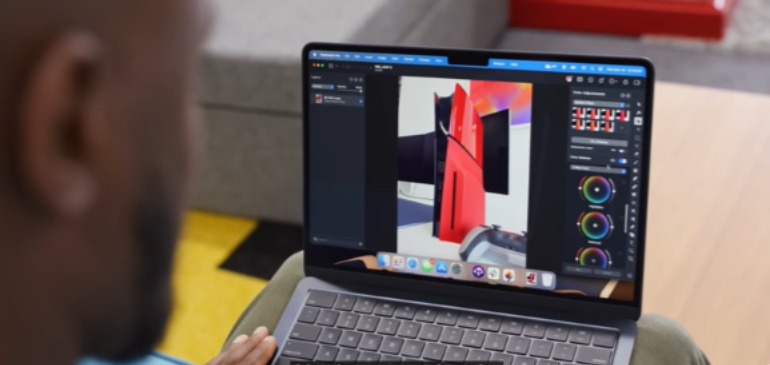It’s crazy that the most interesting things about this new laptop are reasons not to buy it. So, the MacBook Air just got refreshed. It’s actually a pretty straightforward update, maybe even a bit boring.
What’s New
There are really only two new things. It has a new anodization on the outside, which supposedly makes it slightly more fingerprint-resistant. Inside, it features the new M3 chip.
As for the coating, honestly, it doesn’t make much difference. You’ll still see fingerprints if you handle it regularly without a skin or case. I’d prefer relying on something like a skin from our sponsor, Dbrand.
It allows you to choose from three simple colors and hides fingerprints much better than any metal treatment could. Plus, it’s real leather, so it has a luxurious texture that will develop a patina over time. I’ll leave a link to that below.
But the other new thing is the M3 chip inside. Apple tends to use the same chip across their devices. This one came out last October and quickly found its way into the new iMac.
We also got a new MacBook Pro with this and the M3 PRO and M3 Max. So, okay, it’s the new M3 Apple silicon, third generation, great. Now we’re finally getting this new base M3 chip in the new MacBook Air. Side note, why did it take so long? Who knows, Apple seems to stagger releases, maybe intentionally, but it’s the same chip everywhere.
They’ve used it in the iMac, MacBook Pro, and MacBook Air, while the Mac Mini sticks with M2, which is a bit odd. The new iPad Pro also remains on M2. When will that get an upgrade?
Anyway, you already know the MacBook Air is the most popular Mac for a reason. It’s the entry-level Mac that most people see as their gateway into the Mac world. The base MacBook Air has usually been one of the easiest laptops to recommend design-wise. But this one, interestingly, for two reasons, isn’t.
Performance
Now, this isn’t about the performance of the M3 or anything strange like that. It performs as expected. Benchmarks show it’s about 10 to 20% faster than the M2, depending on what you’re doing.
This generation leans more towards graphics improvements and finally includes ray tracing. So, any applications or rendering that utilize that will see a noticeable improvement with the M3. It’s clearly a more capable chip.
MacBook Airs, especially the 15-inch model, consistently boast great battery life across the board. You now also get support for dual external displays with the lid closed, or one external display with the laptop open. The base storage on the M3 also seems much improved.
One concern with the previous M2 model was its base storage. Reviewers noted that the base 256GB model used a single SSD module instead of two, which made it significantly slower than the M1 on paper—about 50% slower.
Would you notice if you weren’t told or hadn’t benchmarked it? Maybe, maybe not, but it was disappointing to have slower storage on a new M2, especially with the extra time it took for transferring large files. I’m happy to report that benchmarks for the base storage on the M3 Air look promising. It seems they’ve addressed this issue, which is great news.
Price
The lineup now starts with the MacBook Air M3 at $1099, followed by the M2 at $999, and the M1 is somewhat phased out by Apple but still available at retailers like Walmart or Best Buy.
The MacBook Air’s easy recommendation comes down to everyday users—those who use it lightly for web browsing, music, multiple open tabs, work tasks, occasional compiling, rendering, photo editing, and cutting a video or two.
These people, the ones who would buy a laptop at Walmart, would likely be perfectly fine with the cheaper, identical-looking MacBook Air with the slightly slower M2 chip and slower storage. I think they’d be just fine.
Base Specifications
But let’s talk about the whole base specification thing. This isn’t new to the industry, but the starting price and base specs have become somewhat of a strange fallacy. Like Linus said in his video, “starting at” is often the biggest lie in tech.
It’s not just tech; the car industry does it all the time too. The starting price is really to give you an idea of how much you’ll spend when you actually configure it the way you want. The issue here is Apple’s markup prices for upgrades above the base spec are ridiculously high.
Since Apple Silicon computers are all system-on-chip, they can’t be upgraded after purchase. So once you buy it, you’re somewhat encouraged, if you plan to keep it for a while, to splurge a bit and future-proof it by upgrading the specs. But Apple charges so much for these upgrades that the base price feels more like a lie than usual. The MacBook Air starts in 2024 with 8GB of shared RAM and 256GB of storage.
Now, my phone has more than 8GB of RAM and 256GB of storage. If you want to upgrade to 16GB of memory, the first available RAM upgrade costs $200. And upgrading to just half a terabyte of storage adds another $200. Compared to what these upgrades actually cost Apple, especially at their scale, it’s crazy, brutal pricing.
So even if you do just those upgrades, suddenly the MacBook Air M3 is $1500. So, okay, are you cool with knowing you’re actually buying a MacBook Air for over $1500? Or is the real question whether the base specs in 2024 are actually usable? You decide.







